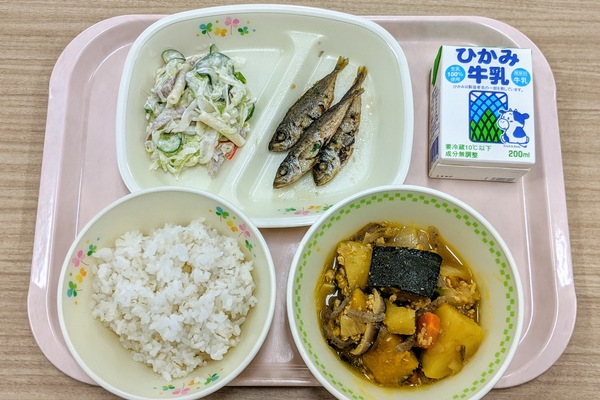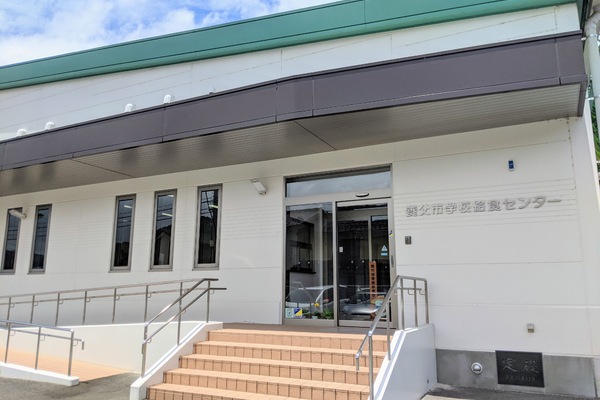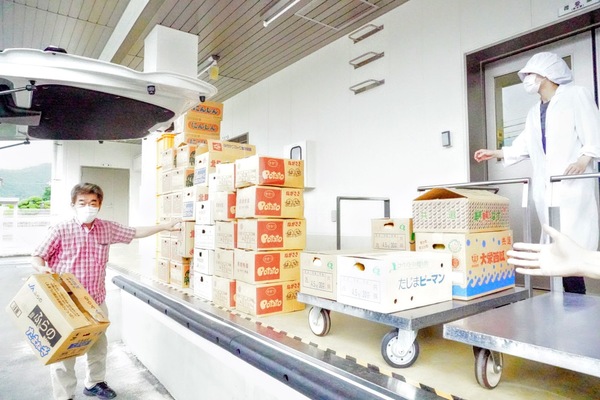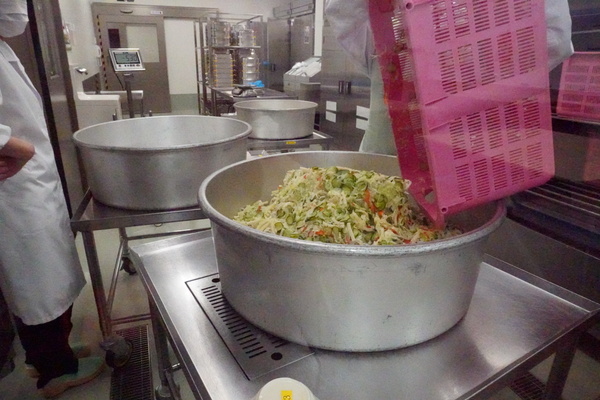



In Japan kyushoku, or school lunches are part of the norm for the majority of elementary school students. The Kyushoku produced in Yabu City is truly impressive and strives to use at least 30% locally made produce with a team of nutritionists who create a monthly menu of well-balanced meals focused on including components of washoku, or Japanese cooking such as beans and seaweed. The Kyushoku Center prepares around 1900 meals daily and delivers the meals to 13 schools which include 9 elementary and 4 middle schools. Before the formation of Yabu City, there were 4 Kyushoku Centers dedicated to each of the areas Yabu, Oya, Sekinomiya, and Yoka. After the merging of the four towns in 2004, there was a movement towards building a single Kyushoku Center for the entire city, this was finally established in January of 2015.
The kyushoku in Yabu is a well-balanced meal that usually contains two side dishes, rice (100% locally grown), a soup or stew, a box of milk, and occasionally a dessert. The menu is different every day and strives to follow the traditional washoku concept of 一汁三菜 (Ichi jyu sansai) meaning one soup dish and 3 side dishes (the soup, in this case, counting as the third dish since it contains vegetables and protein).
On the morning of my visit to the Kyushoku Center, I was shown around by Nobuko Igaki who is the current chief operator. Just as I arrived there was a morning delivery of local produce by truck including onions, potatoes, and various produce that would be used for the lunch prepared that day. As per regulations, it is required that all kyushoku is made on the day of, to ensure that the freshness and quality of each meal are preserved and maintained. I was briefly shown around and brought to the meeting room surrounded by clear glass which allowed me to get a peek of the cooks preparing the kyushoku for that day. Each room in the Kyushoku Center is dedicated to a specific dish. This includes the giant pots in the central room for cooking soups and stews, a room for frying and grilling, a room for mixing salads, a room dedicated to preparing dishes for students with allergies, and more. Throughout the entire time that the cooks are preparing the meals, there are small announcements made to make sure that their hair is tucked under their hats and to check for any holes in their rubber gloves to check that everything remains sterile and clean.
During my visit I was able to observe them make one of the dishes for that day; macaroni salad. While the salad was prepared, it was cautiously measured by a scale and separated into 3 even batches. Each portion weighed around 35 kg (40 kg including the container) requiring two male workers to separate and carry them. The salads are refrigerated and the temperature of each batch is measured to ensure that it is chilled and stays fresh during the hot summer months. Once taken out of the fridge, each salad was mixed with great vigor as the dressing and seasonings were mixed in requiring much strength to accomplish the job. The nutritionist would occasionally check-in to make sure things were going as planned. Afterward, the salad was carefully measured and separated into canisters assigned to each school to ensure that everything was evenly distributed. Each cooking task is executed with careful precision and with multiple checks in between to confirm that the process is done accurately.
I was able to also meet with one of the three main nutritionists at the center, Mayumi Okuyama. I was truly in awe of her dedication, modesty, and passion towards ensuring that the Kyushoku Center provides the best quality meals that all of the children can enjoy. She has a “never settle for less” attitude and continuously strives to make improvements upon improvements to ensure that they can maintain and provide top-notch quality meals. She stressed how communication is key among the workers at the Kyushoku Center. From daily meetings to check-ups in the kitchen, communication is what keeps the operation running smoothly. She mentioned how there may be some bumps and hurdles occasionally, but because of the constant communication, they can swiftly overcome difficult situations or unexpected occurrences that they may run into. In 2018 the Kyushoku Center in Yabu won the title of the Kyushoku Koshien a national competition held in Japan awarding the best kyushoku in the nation. I mentioned this to Ms.Okuyama, but she stressed saying “今は今” (ima wa ima) meaning the importance of the now and not the past glory. She and her colleagues show true humble and modest qualities which further exudes the professionalism that they display. She emphasizes the importance of continuously maintaining as well as improving the quality of the kyushoku that they continue to serve daily.
One of the main goals of the Kyushoku Center is the promotion of 食育 (shokuiku) or food education. The center prioritizes providing delicious, safe, and nutritious meals, but they also incorporate other components of food culture such as the importance of using local produce, proper table manners, and serving foods associated with local celebrations. Shokuiku also teaches students to have gratitude for the food, by having them learn what goes into the process of making, growing, and preparing the meals that are served to them daily. Ms. Okuyama explained to me how some students may not like certain foods such as green bell peppers, a common dislike by many children in Japan due to its bitter taste. She stressed that by having some students go through the process of cooking and preparing the meal themselves, they will learn to take the challenge of trying the food instead of dismissing it completely since they associate the work that they did with the dish. To accomplish this they sometimes have the students participate in preparing some of the vegetables that will be used for the kyushoku that day this includes food prep such as peeling beans. Some of the schools such as Hirotani Elementary School, have students raise a vegetable garden as part of their learning curriculum to teach the students the process of raising vegetables. The Kyushoku Center also occasionally does visits to each of the schools to discuss the importance of shokuiku, and to share what goes into the process of making kyushoku. It is vital to know the story behind where our food comes from, as well as the process behind how it is prepared. When the time, effort, and care that is put into the process or development of food is realized there is a greater appreciation for the finished product. The Kyushoku Center accomplishes this for the students through shokuiku.
My visit to the Kyushoku Center was truly an amazing experience that left me in awe of how much effort, passion and pride that the nutritionists and workers at the center have for not only providing exceptional kyushoku but teaching the students the importance of appreciating food and learning of the various components that are embedded within the food culture in Yabu. It was a magical time to be able to see the process and learn about what composes the kyushoku culture in Yabu City. I most definitely hope to be able to try their kyushoku once again!
For more information watch this documentary filmed by Yabu City about the Kyushoku Center.
Leave a Reply